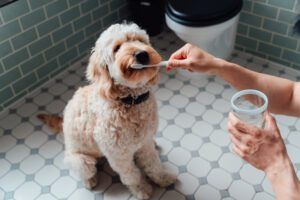What’s the best way to keep your dog’s teeth clean and her breath fresh? There are dozens of canine toothpastes, but homemade dog toothpaste and other dental products you make yourself is an easy, economical way to support your dog’s oral health with natural ingredients. Whether you use a made-for-dogs toothbrush or a finger sleeve designed for canine tooth cleaning, routine brushing exponentially improves your dog’s dental health.
You can experiment to design a custom toothpaste for your pup. The basic recipe calls for some sort of edible oil, which makes the lubricating base for the dog toothpaste; I love to use high-quality unrefined or “virgin” coconut oil for this purpose. Baking soda (sodium bicarbonate) is used as an abrasive cleaning agent. And you can use a variety of foods as flavoring agents that will help your dog enjoy the brushing experience.
Is baking soda bad for dogs?
Baking soda is the most popular DIY toothpaste ingredient because it is widely available, inexpensive, and cleans teeth mechanically by scrubbing plaque and surface stains with mild abrasion. In addition, it helps prevent bad breath.
Some veterinarians warn that baking soda shouldn’t be used in homemade dog toothpaste because if enough is swallowed, it can upset the stomach and digestive tract (remember, dogs don’t spit out the toothpaste, but will end up swallowing much of what you use). However, according to Blackwell’s Five-Minute Veterinary Consult by G. Oseiler,et al (Wiley-Blackwell, 7th Edition, 2021), symptoms of baking soda toxicity tend to occur after a dog has ingested 10 to 20 grams of baking soda per kilogram of body weight, which equates to about 1 to 2 tablespoons baking soda per pound of weight. Dogs are unlikely to be harmed by the tiny amounts that end up in their mouths, given that the baking soda is used in a relatively small amount, combined with other ingredients, and applied in tiny amounts on the toothbrush.
Ingredients to use in homemade dog toothpaste
Dog toothpastes often employ an edible fat as the base. Keep in mind that the toothpaste should be refrigerated after mixing the ingredients together. Here are some good choices to consider for the base:
- Coconut oil is recommended for canine tooth cleaning because its medium-chain fatty acids have antimicrobial effects. In addition, coconut oil has a soap-like consistency when it interacts with saliva, which helps prevent the growth of harmful bacteria. To melt coconut oil, place it in a measuring cup placed in hot water or briefly microwave.
- Olive oil and other vegetable oils are attractive to most dogs and, in small amounts, they are effective flavoring agents. In addition, they help distribute other ingredients during brushing.
- Pan drippings from roasted meat or chicken combine favorite flavors with gelatin that, when refrigerated, stays on a toothbrush and encourages dogs to enjoy the brushing process.
Candidates to use as flavoring agents for dog toothpaste have to appeal to dogs, not us. So forget the minty flavors that humans enjoy. Here are better choices for dogs:
- Bouillon, a concentrated meat stock sold as a paste or powder, can be added to home-prepared toothpastes. Look for salt-free or low-salt bouillon, or use very small amounts.
- Brewer’s yeast is a strain of Saccharomyces cerevisiae, which is used in beer making, hence its name. It is sold as a nutritional supplement powder because of its high vitamin B content, minerals, and amino acids, and it is added to some dog foods to enhance their flavor.
- Yogurt and kefir are fermented milk products known for their beneficial bacteria, which help maintain a balanced oral (as well as digestive) microbiome. Use plain, unflavored products.
- Herbs and spices like mint, ground cinnamon, and parsley are often recommended. Try them, but let your dog decide whether they’re worth including.
To make the dog toothpaste, combine 1/4 cup coconut or other vegetable oil with 2 tablespoons baking soda, 2 tablespoons yogurt, and a few pinches of any other dog-safe flavoring agents in a small glass jar. If you want to use bouillon, stir 1 teaspoon beef or chicken bouillon into 1 tablespoon hot water and then mix into the base with the other ingredients. Stir well, refrigerate, and when ready, apply some to your dog’s toothbrush.

